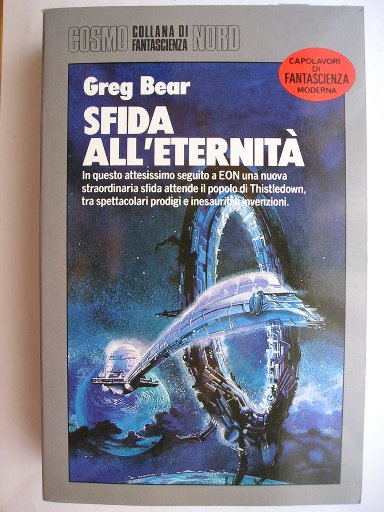
The novel “Eternity” by Greg Bear was published for the first time in 1988. It’s the sequel to “Eon” and the second novel in the Way series.
A few decades after the separation of the Thistledown from the Way, the Hexamon is helping the people of Earth to heal the planet after the nuclear devastation but not all natives are happy with that situation. Part of the inhabitants of Thistledown want to reopen the Way even if the danger of the Jart remains high. The return in mysterious circumstances of Pavel Mirsky, who had embarked on a journey on the Way before its closure, adds a new element to the issue.
Olmy is informed by an old friend that secretly a Jart had been captured but even if it was apparently dead any attempt to examine its mind had caused damage and even death to the investigators. The success of that exam could provide valuable information about the Jart but it could also be a Trojan horse sent to hit the Hexamon from within.
Patricia Vasquez is dying after living for decades in a parallel world in which Alexander the Great lived to consolidate his empire, which still exists. She entrusts the equipment she had brought with her and her knowledge to her granddaughter Rhita, whi has the grave task of finding space-time gates opening on the Way.
“Eon” is a hard science fiction novel of great complexity, its sequel “Eternity” is someway even more complex but it’s actually easier to understand. This paradox is explained by the fact that all the bases of the series were laid in the first novel, which of course must be read before proceeding with the second one.
In “Eternity”, Greg Bear further develops the themes introduced in “Eon” resuming the stories of some characters after a few decades and introducing new ones. The novel takes place in two separate universes because at the end of the first novel Patricia Vasquez arrived in a parallel universe and that subplot continues in the second novel with her granddaughter Rhita.
It’s mainly through Rhita that Greg Bear tells us about Gaia, as Earth is called in that parallel universe where Alexander the Great’s empire didn’t get fragmented after his death. Rhita continues the research started by her grandmother of space-time openings that lead to the Way but she must juggle the political problems of a declining empire.
In the universe in which the events of “Eon” happened, the Hexamon is dealing with various problems. The Earth’s Old Natives aren’t happy to receive aid in the healing operations of the planet like kids who want to become independent from their parents and make their own choices, even difficult ones. It’s a curious reversal of a classic generational conflict because the Thistledown came from the future, though from another universe, so the Hexamon members are part of generations much younger than the ones living on the Earth.
The disagreement between the Old Natives and the Thistledown citizens is often about the way to deal with death. The technologies available to the Hexamon allow people to achieve immortality but many Earthlings refuse them accepting to die. However, There’s no common approach for all the Old Natives so being more or less open or close to these technologies is an individual decision.
The basic theme of “Eternity”, however, is the discussion on the possibility of reopening the connection to the Way. The Hexamon had closed it because of the threat of the Jart, an alien species considered very dangerous and warlike. One of the themes that are strongly developed in this novel concerns precisely the Jart, whose way of thinking and motivations are revealed.
Another of the themes developed in “Eternity” is connected to the Way and also to the Jart thanks to the return of Pavel Mirsky. The Russian tells the extraordinary story of his journey on the Way and his encounter with god-like creatures. Greg Bear has often been compared to Arthur C. Clarke and one of the things in common between the two writers is the way they dealt with the theme of transcendence.
Pavel Mirsky tells the story of intelligence in a distant future which resemble the concept of the Omega Point coined by the Jesuit philosopher Pierre Teilhard de Chardin. Greg Bear uses the concept giving it a scientific basis but especially at certain times the tones seem very religious.
These themes are developed in the course of “Eternity” in the various subplots that eventually converge. As in “Eon”, there are many characters but most of them had already appeared in the first novel so they’re already developed and it’s easier to understand their motivations to focus on the plot.
“Eternity” is a overall another great novel to continue the story started in “Eon”. Sometimes sequels simply continue a story ending up making it a little dull, instead in this case Greg Bear manages to add new elements that strengthen it. If you were satisfied with “Eon” you have to read this sequel too.

